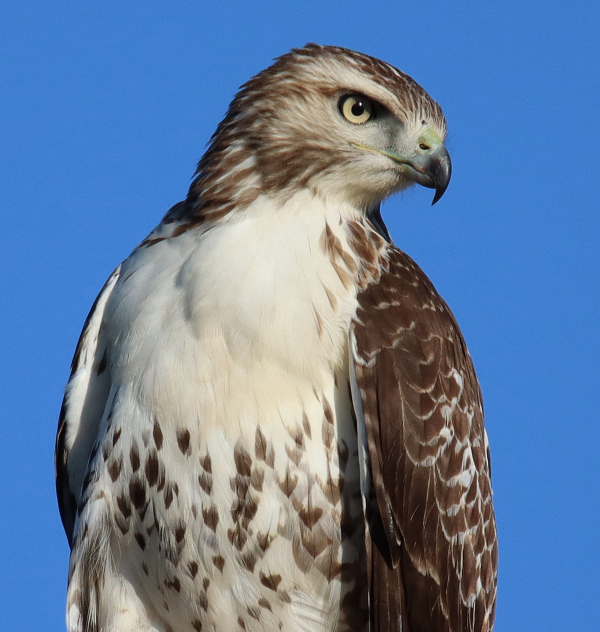
Raptor migration is bringing more birds of prey into the area, including young Red-tailed Hawks on their first migration south.

A migrating Red-tailed Hawk provided an interesting opportunity to photograph it soaring with midday backlighting.
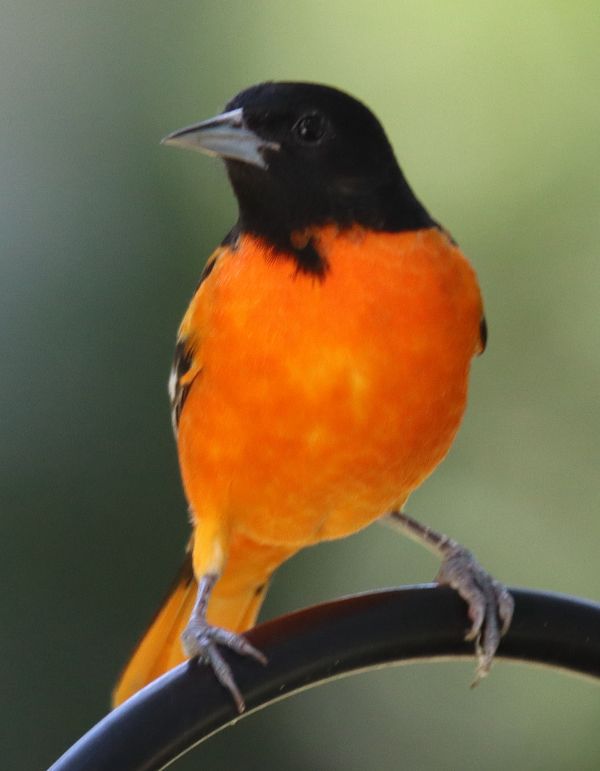
The bright colors of a male Baltimore Oriole are most evident with a front view.
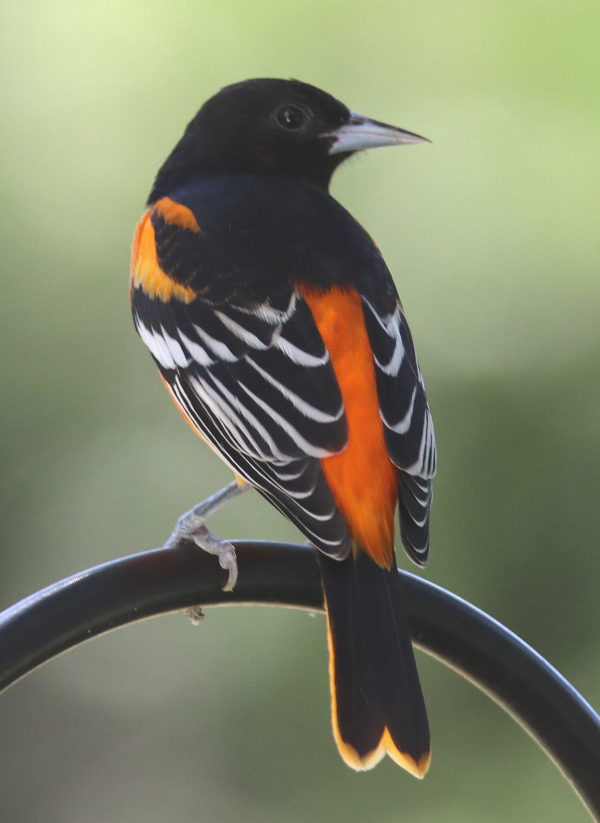
The back view of this male is also striking as it shows the distinctive white borders of the wing feathers and orange border on its tail feathers.
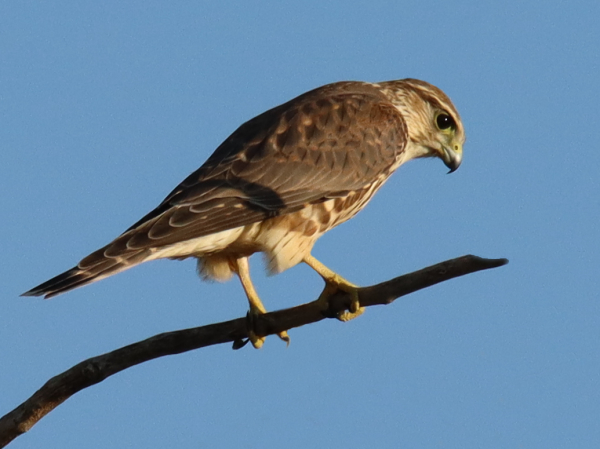
The first Merlin of fall was intently searching for its next hunt.
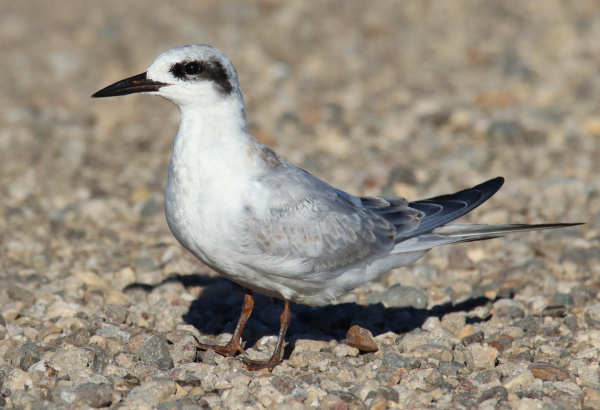
This portrait of a young Common Tern was taken last week at Sand Lake National Wildlife Refuge.
|
Checking from a distance with binoculars, I was delighted to see My first Merlin of fall migration, a young pale Prairie Merlin no less! It was a nice look at this small falcon, and after drinking it in, I released my foot from the brake and eased forward until I saw the little Merlin adjust its tail upward, which prompted me to turn off the engine and focus my camera on the young falcon. I watched the lighting and shadows on its face as it turned its head as its search for a hunt. It was a bit of a breakthrough, as the first Merlin of the season to cross my path.
I was also on the lookout for kingbirds, having observed a big concentration of Eastern Kingbirds numbering in the hundreds last week that I expected was on the verge of migrating. It was obvious most kingbirds had evacuated the area, in spite of the fact that small flying insects may be at peak numbers. Eventually, I found 2 Eastern Kingbirds, and later 3 more. But it was even more fun to see a young Western Kingbird, a beautiful bird in its new plumage, hawking insects on the ground and from low perches. Western Kingbirds vacated the area about 10 days before the Easterns concentrated, so it was a nice to see this trusting young Westie – probably the last one I’d see in Dakota until next May.
Two other species were obviously concentrated in larger numbers too – Western Meadowlarks and Wood Ducks, including a flock of about 40 Woodies and another group of about 15. Wood Ducks are not very common in this prairie region, so to see flocks of these ducks, made up of mostly males, was significant. There was also a group of 5 Northern Flickers, although they may have represented a family group rather than a migrating flock. Although I haven’t seen any warblers in my yard recently, I did see a male Yellow Warbler in the same grove of trees as the flickers.
Sand Lake Area
I timed my return trip from Aberdeen, South Dakota to coincide with the best evening sunlight as I detoured a few miles to swing through Sand Lake National Wildlife Refuge. South of the refuge, near the little town of Columbia, there was a large concentration of wading birds in a floodplain area, mostly Great Egrets, but also many Great Blue Herons and a few White-faced Ibis. There were also concentrations of Pied-billed Grebes, Wood Ducks and Mallards, and a few Double-crested Cormorants. While getting an overview of the hundreds of birds, I caught sight of the silhouette of a Bald Eagle flying low carrying a fish in its talons, and moments later I saw a second eagle following the first. Although I could only see silhouettes of the eagles, it may have been an adult with the fish and an older fledgling following it to the nest I know is located just south of the wetland.
A few miles before the wading birds, a Red-headed Woodpecker caught my attention adjacent to a grove of large cottonwood trees. When I stopped, 1 by 1 a total of 4 woodpeckers assembled, including 3 fledglings and an adult – a fun find in the state south of home.
In the refuge proper, large assemblages of ducks were obvious, along with a loafing group of White Pelicans and cormorants. A few Great Blue Herons were scattered as were small flocks of Giant Canada Geese. My favorite stop was along a gravel road that bisected the James River floodplain, where an adult-sized brood of Redheads and another of Mallards was loafing among molting Mallards and Blue-winged Teal on the shoreline, while a mixed flock of Ring-billed Gulls, Common Terns, and a Black Tern likewise rested and preened. I was most surprised by 3 Wilson’s Snipe that took flight as I passed, the first snipe I’ve seen in some time.
On both sides of a bridge where the river rushed a little faster through the narrowed channel were several family groups of Western Grebes, including young grebes ranging in age from 3 weeks to 6 that were being fed fish periodically by adults. The grebes were active in calm water that produced beautiful shades of blue, providing a perfect photo location, prompting me to park on the side of the bridge and wait for avian action within photo range. The setting had an especially calming effect, like I had the world to myself, tempered with periodic interactions among the grebes, and the unannounced flight of an American Bittern across the stern of my vehicle that prompted a photo. Bitterns have been unusually uncommon this summer, especially when compared to the past couple years. Although most Common Nighthawks have left the region, a late nighthawk began flying low above an area of cattails, which led me to follow its flight with photos in mind, but it didn’t angle my way. Even so, I appreciated the hushed evening, broken only by the occasional contact calls of Western Grebes.
That’s when the owls began hooting in the distance, which made me question if it was a dove instead, but it was definitely the call sequence of a Great Horned Owl; and after a few calls, a more distant owl responded in kind. Time to go, but that wasn’t the last of the Great Horned Owls for the evening. While acknowledging the broods of Ring-necked Pheasants along the road on my return home, along with a scattering of Swainson’s and Red-tailed Hawks, the last bird I saw at dusk was a Great Horned Owl that took flight as I passed, winging in front of my windshield at a safe distance but providing a close low-light view of the night predator.
Orioles & More
Thursday provided renewed action at my jelly feeder for a minimum of 7 Baltimore Orioles, including 3 adult males – happily, the white-winged male that I described last week was among them. They seemed to have heightened feeding activities, and I often noticed 3 and 4 orioles arriving at a time – each waiting a turn in the branches adjacent to my feeding station, or perched on the unused hummingbird feeder. Although the wind reversed early Friday morning from south to north, the oriole action was similar throughout the day, and no hummingbirds or other migrants arrived – maybe Saturday.
Indeed, Saturday at least 2 Ruby-throated Hummingbirds arrived, but all the 3 male Baltimore Orioles apparently jumped the north wind southbound – adios amigos. One other migrant appeared Saturday, perched in the mid-story of the sumacs nearest to the feeding station – an Ovenbird! I’ve had Ovenbirds in my yard during spring migration, but never during fall, so that was a record yard sighting. But wait, it was also the only Ovenbird I’ve seen outside the month of May – anywhere – and then it was gone. Sunday and Monday 1 hummingbird continued to stop by, along with 3 young orioles.
By Tuesday, after the wind changed from the north again, only 1 oriole visited the feeding station periodically, but no hummingbirds. Well, the north wind taketh, and the north wind will bring more birds soon; and the fact that my feeding station is all but inactive for the day, makes the hushed excitement related to what birds will arrive next is just part of the feeding station story. But suddenly a new migrant arrived, a new hummingbird, easily identifiable as such by its nervous behavior at the feeder, and its preference to feed while hovering rather than while perched like its predecessors – welcome, who’s next?
Raptor Wind
Although the north wind was quite strong, which usually mutes bird activities, I wanted to see if any raptors or other migrants were actively moving; and I decided to take a different route to the north, then a couple miles west, then south. A bit more than a mile north of my office, a marshful of ducks flushed en masse, which made me look for a raptor, and some distance to the west sighted a young Bald Eagle in flight, pointed headlong into the north wind. I paralleled its flight for a mile, but as it angled farther away, my attention was drawn to a concentration of nearly 100 Double-crested Cormorants perched on the bare limbs of some flooded cottonwood trees.
I didn’t encounter anything more out of the ordinary until the end of my drive, just 2 miles southeast of my office, where a sudden falcon flash zipped low above my windshield. Immediately I knew it was a Merlin as it sped by with its wings closed in a dive to stay low below the tall vegetation on the left side of the vacated road; it quickly elevated with the likely intent of surprising a small bird. It elevated to about 20 feet after that, still zooming south. After seeing the first Merlin of the year the day before, it was fun to get a look at a second Merlin on consecutive days.
At peak lighting, I observed one of the Swainson’s Hawks in the territory about 6 miles to the south of my office, which turned out to be the rufous morph adult I have been interested in photographing. I stopped farther away than usual, which allowed me to get out of my vehicle on the top of the same hill where the hawk was perched with its back to the sun. For the rest of the story and some of the resulting photos, I’m going to refer you to the Bird Photography feature in this issue – the rufous hawk provided a great thrill for me in just a few moments of interaction time, and there is a historic context between that individual hawk and I.
Holiday Weekend
With perfect weather conditions – 76 degrees and no wind – Saturday afternoon I took an expansive drive through my regular southside birding route, through the 10 woodpecker territories, and beyond on a somewhat exploratory extension of those 2 areas, which yielded some different birds, some the same. Among them I was happy to find Merlin number 3, the 3rd Merlin in 3 days! I also had a chance to photograph a Red-headed Woodpecker fledgling as it perched on a dead branch in between insect-catching flights. Other notable birds included a Sharp-tailed Grouse, 3 American Kestrels, and 3 Northern Harriers. Speaking of harriers, I haven’t seen a fledgling harrier yet this year; a testament to a poor raptor nesting season, which puzzles me.
Sunday was windy, so I cut back on my birding range, but even close to home I appreciated some different birds, including a Sora, a rarely seen rail in these parts owing to their secretive nature, which was in loose company with 3 Wilson’s Snipe just 1½ miles north. At my shorebird checkpoint to the south, I found the first Long-billed Dowitcher feeding, then preening, then resting with its bill tucked into the plumage on its back. It was a beautiful bird with new basic plumage that really seemed to show the details in each feather in the photos I took of this lone dowitcher – usually fall dowitchers are found in flocks, small or large. Throughout the drive, I watched intently for a 4th Merlin in 4 days, but on my way back I settled for a female American Kestrel. I didn’t see any Black Terns along the way, nor any kingbirds, but did see a Say’s Phoebe on the eastern edge of the species’ range.
Of course there were many other birds along the way – the usuals – but while there were some small flocks of Western Meadowlarks and Mourning Doves, the biggest flock of migrants showed up 75 yards south of my house. As I parked out front I noticed a flock of American Robins flying in 2s and 3s to a small pond of water – a flock that must have numbered betwen 35 and 45 – a lot considering I haven’t seen robins in the area for a couple weeks. As I was writing this, a couple of the robins perched outside my bay windows, perhaps checking out some chokecherries before the evening light faded.
During an extended holiday birding drive Monday that took me through the best “local” raptor area that took me west then north of my office, then east and south. With more Red-tails in the area, and more Swainson’s too, I was interested in getting a baseline look at raptors along that route. I always remember the Labor Day weekend having a big push of Red-tailed Hawks into the area, from northern latitudes I’s expect, but Swainson’s Hawks were clearly the raptors of the day. I observed a total of 23 Swainson’s Hawks, 9 Red-tailed Hawks, 3 Northern Harriers, 2 young migrating Cooper’s Hawks (separate), 2 American Kestrels (together), but no Merlins, for a total of 39 raptors – a good baseline start. Actually, 39 raptors beat the total counted at Hawk Mountain Monday, along with many other raptor count sites, and rivaled the 42 raptors counted throughout the day at Corpus Christi, Texas – always a fall migration hotspot. The difference is that raptors are spread out across the open plains rather than being funneled by bodies of water or mountain ridges.
Along the way, I also found 2 flocks of Sharp-tailed Grouse numbering 6 and at least 2, probably more, along with 3 Franklin’s Gulls among many scattered Ring-billed Gulls. Wading birds were diverse, including 4 Great Blue Herons, 6 Great Egrets, 1 Snowy Egret, and 3 White-faced Ibis. Of course, the most abundant birds along the way were the flocks of ducks in eclipse plumage –Blue-winged Teal, Mallards, and Ruddy Ducks were most evident – and I was glad to see 4 Northern Shovelers back in the area, actively feeding as a group. There were also a couple flocks of Giant Canada Geese feeding in harvested wheat fields, and a couple flocks of Tree Swallows were actively feeding on the wing too. On the edge of the lake 1½ mile north of home, a few new shorebirds graced a shallow bay, including the first 6 American Avocets I’ve seen in several weeks, 3 Long-billed Dowitchers, a couple Greater Yellowlegs, and a few Lesser Yellowlegs. Overall, a great assortment of birds, many early fall migration arrivals among them.
Hope you enjoyed a fine holiday weekend and managed to find some birding excitement in the mix of your activities. Even when we are caught up with other things during the week, watch for that one bird that can bring a little extra excitement into your day. Each September day should reveal new birds among us – some we may search out, but some are apt to cross our paths as we do a variety of other things: Like the Ovenbird that gave me a moment of excitement and my first-ever fall sighting of the species, it’s often when we least expect it that an explanation mark of a bird suddenly appears – it can make your day!
Article and photos by Paul Konrad
Share your bird sightings and photographs at editorstbw2@gmail.com